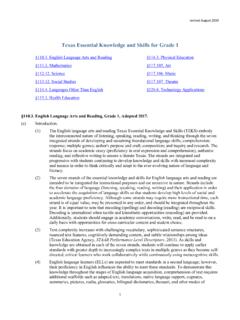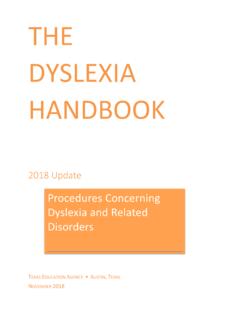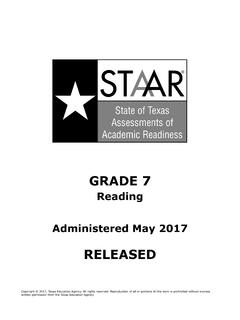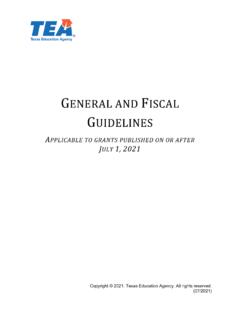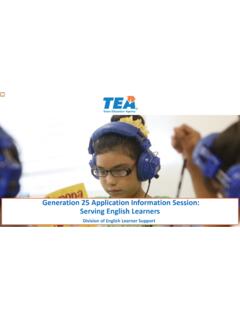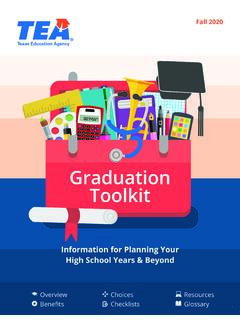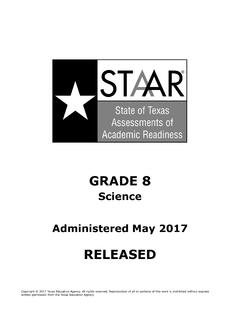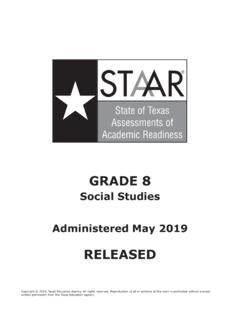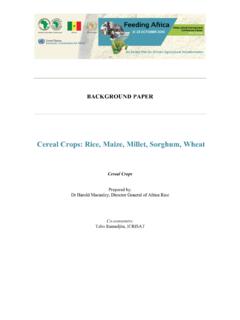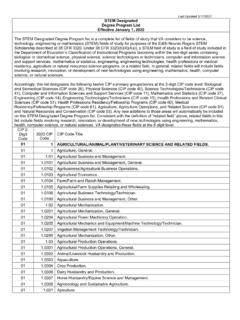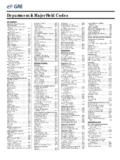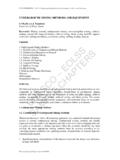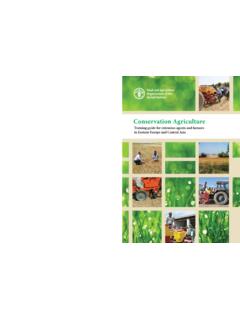Transcription of United States History - Texas Education Agency
1 _____. TEKS Curriculum Framework for STAAR Alternate 2. United States History The 2019 version of the TEKS Curriculum Framework for Social Studies has been updated to include the streamlined social studies TEKS for middle school and high school, which are to be implemented in classrooms beginning with the 2019-2020 school year. Next year, the 2020 version of this document will include the streamlined social studies TEKS for kindergarten through grade 5, which are to be implemented in classrooms beginning with the 2020-2021 school year. The 2019 version of this document is valid only for the 2019-2020 school year. Copyright December 2019, Texas Education Agency . All rights reserved. Reproduction of all or portions of this work is prohibited without express written permission from the Texas Education Agency . Social Studies TEKS Curriculum Framework for STAAR Alternate 2 | US History STAAR Reporting Category 1 History : The student will demonstrate an understanding of issues and events in History .
2 TEKS Knowledge and Skills Statement/ Essence of TEKS Knowledge and Skills Statement/. STAAR-Tested Student Expectations STAAR-Tested Student Expectations United States History (1) History . The student understands the Recognizes the importance of the Declaration of Independence and principles included in the Celebrate Freedom Week program. The the Constitution. student is expected to (A) analyze and evaluate the text, intent, meaning, and importance of the Declaration of Independence and the Constitution, including the Bill of Rights; Supporting Standard (B) analyze and evaluate the application of these founding principles to historical events in History ; Supporting Standard (C) explain the meaning and historical significance of the mottos E Pluribus Unum and In God We Trust. Supporting Standard Prerequisite Skills/Links to TEKS Vertical Alignment Historical Significance of Patriotic Celebrations and National Landmarks explain the significance of various community, state, and national celebrations such as Veterans Day, Memorial Day, Independence Day, and Thanksgiving (2).
3 Describe the origins of customs, holidays, and celebrations of the community, state, and nation such as San Jacinto Day, Independence Day, and Veterans' Day (1). explain the reasons for national patriotic holidays such as Presidents' Day, Veterans Day, and Independence Day (K). Concepts of Time and Chronology apply the terms year, decade, and century to describe historical times (3). create and interpret timelines (3). use vocabulary related to chronology, including past, present, and future times (3). describe various evidence of the same time period using primary sources such as photographs, journals, and interviews (2). identify several sources of information about a given period or event such as reference materials, biographies, newspapers, and electronic sources (2). create and interpret timelines for events in the past and present (2). apply vocabulary related to chronology, including past, present, and future (2). describe the order of events by using designations of time periods such as historical and present times (2).
4 Create a calendar and simple timeline (1) Continued December 2019 1. Social Studies TEKS Curriculum Framework for STAAR Alternate 2 | US History Prerequisite Skills/Links to TEKS Vertical Alignment describe and measure calendar time by days, weeks, months, and years (1). distinguish among past, present, and future (1). use vocabulary related to time and chronology, including before, after, next, first, last, yesterday, today, and tomorrow (K). place events in chronological order (K). December 2019 2. Social Studies TEKS Curriculum Framework for STAAR Alternate 2 | US History STAAR Reporting Category 1 History : The student will demonstrate an understanding of issues and events in History . TEKS Knowledge and Skills Statement/ Essence of TEKS Knowledge and Skills Statement/. STAAR-Tested Student Expectations STAAR-Tested Student Expectations United States History (2) History . The student understands Recognizes important dates and time periods in History from traditional historical points of reference in History from 1877 to 1877 to the present.
5 The present. The student is expected to (A) identify the major eras in History from 1877 to the present and describe their defining characteristics;. Readiness Standard (B) explain the significance of the following years as turning points: 1898 (Spanish-American War), 1914-1918 (World War I), 1929 (the Great Depression begins), 1939-1945. (World War II), 1957 (Sputnik launch ignites space race), 1968 (Martin Luther King Jr. assassination), 1969 ( lands on the moon), 1991 (Cold War ends), 2001. (terrorist attacks on World Trade Center and the Pentagon), and 2008 (election of first black president, Barack Obama). Supporting Standard Prerequisite Skills/Links to TEKS Vertical Alignment Historical Significance of Patriotic Celebrations and National Landmarks explain the significance of various community, state, and national celebrations such as Veterans Day, Memorial Day, Independence Day, and Thanksgiving (2). describe the origins of customs, holidays, and celebrations of the community, state, and nation such as San Jacinto Day, Independence Day, and Veterans' Day (1).
6 Explain the reasons for national patriotic holidays such as Presidents' Day, Veterans Day, and Independence Day (K). Concepts of Time and Chronology apply the terms year, decade, and century to describe historical times (3). create and interpret timelines (3). use vocabulary related to chronology, including past, present, and future times (3). describe various evidence of the same time period using primary sources such as photographs, journals, and interviews (2). identify several sources of information about a given period or event such as reference materials, biographies, newspapers, and electronic sources (2). create and interpret timelines for events in the past and present (2) Continued December 2019 3. Social Studies TEKS Curriculum Framework for STAAR Alternate 2 | US History Prerequisite Skills/Links to TEKS Vertical Alignment apply vocabulary related to chronology, including past, present, and future (2). describe the order of events by using designations of time periods such as historical and present times (2).
7 Create a calendar and simple timeline (1). describe and measure calendar time by days, weeks, months, and years (1). distinguish among past, present, and future (1). use vocabulary related to time and chronology, including before, after, next, first, last, yesterday, today, and tomorrow (K). place events in chronological order (K). Historical Points of Reference identify the major eras in Texas History , describe their defining characteristics, and explain the purpose of dividing the past into eras, including Natural Texas and its People; Age of Contact; Spanish Colonial; Mexican National; Revolution and Republic; Early Statehood; Texas in the Civil War and Reconstruction; Cotton, Cattle, and Railroads; Age of Oil; Texas in the Great Depression and World War II; Civil Rights; and Contemporary Texas (7). explain the significance of the following dates: 1519, mapping of the Texas coast and first mainland Spanish settlement; 1718, founding of San Antonio; 1821, independence from Spain; 1836, Texas independence; 1845, annexation; 1861, Civil War begins.
8 1876, adoption of current state constitution; and 1901, discovery of oil at Spindletop (7). People, past and present skills connect their life to events, time, and routines (Pre-K). December 2019 4. Social Studies TEKS Curriculum Framework for STAAR Alternate 2 | US History STAAR Reporting Category 1 History : The student will demonstrate an understanding of issues and events in History . TEKS Knowledge and Skills Statement/ Essence of TEKS Knowledge and Skills Statement/. STAAR-Tested Student Expectations STAAR-Tested Student Expectations United States History (3) History . The student understands the Recognizes important political, economic, and social issues in the political, economic, and social changes in the United States from United States from 1877 to 1898. 1877 to 1898. The student is expected to (A) analyze political issues such as Indian policies, the growth of political machines, civil service reform; Readiness Standard (B) analyze economic issues such as industrialization, the growth of railroads, the growth of labor unions, farm issues, the cattle industry boom, the growth of entrepreneurship, and the pros and cons of big business; Readiness Standard (C) analyze social issues affecting women, minorities, children, immigrants, and urbanization.
9 Readiness Standard Prerequisite Skills/Links to TEKS Vertical Alignment Individuals and Groups Shaping History describe the social, political, economic, and cultural contributions of individuals and groups from various societies, past and present (6). describe how individuals, events, and ideas have changed communities, past and present (3). explain how people and events have influenced local community History (2). Issues and Events Shaping History identify the impact of various issues and events on life in Texas such as urbanization, increased use of oil and gas, the Great Depression, the Dust Bowl, and World War II (4). Historical Points of Reference identify the major eras in Texas History , describe their defining characteristics, and explain the purpose of dividing the past into eras, including Natural Texas and its People; Age of Contact; Spanish Colonial; Mexican National; Revolution and Republic; Early Statehood; Texas in the Civil War and Reconstruction; Cotton, Cattle, and Railroads; Age of Oil; Texas in the Great Depression and World War II; Civil Rights; and Contemporary Texas (7).
10 Economic Influences explain how industry and the mechanization of agriculture changed the American way of life (5). identify and explain how changes resulting from the Industrial Revolution led to conflict among sections of the United States (5). identify the impact of railroads on life in Texas , including changes to cities and major industries (4) Continued December 2019 5. Social Studies TEKS Curriculum Framework for STAAR Alternate 2 | US History Prerequisite Skills/Links to TEKS Vertical Alignment explain the growth, development, and impact of the cattle industry, including contributions made by Charles Goodnight, Richard King, and Lizzie Johnson (4). Social Influences identify the challenges, opportunities, and contributions of people from various American Indian and immigrant groups (5). examine the effects upon American Indian life resulting from changes in Texas , including the Red River War, building of forts and railroads, and loss of buffalo (4).

